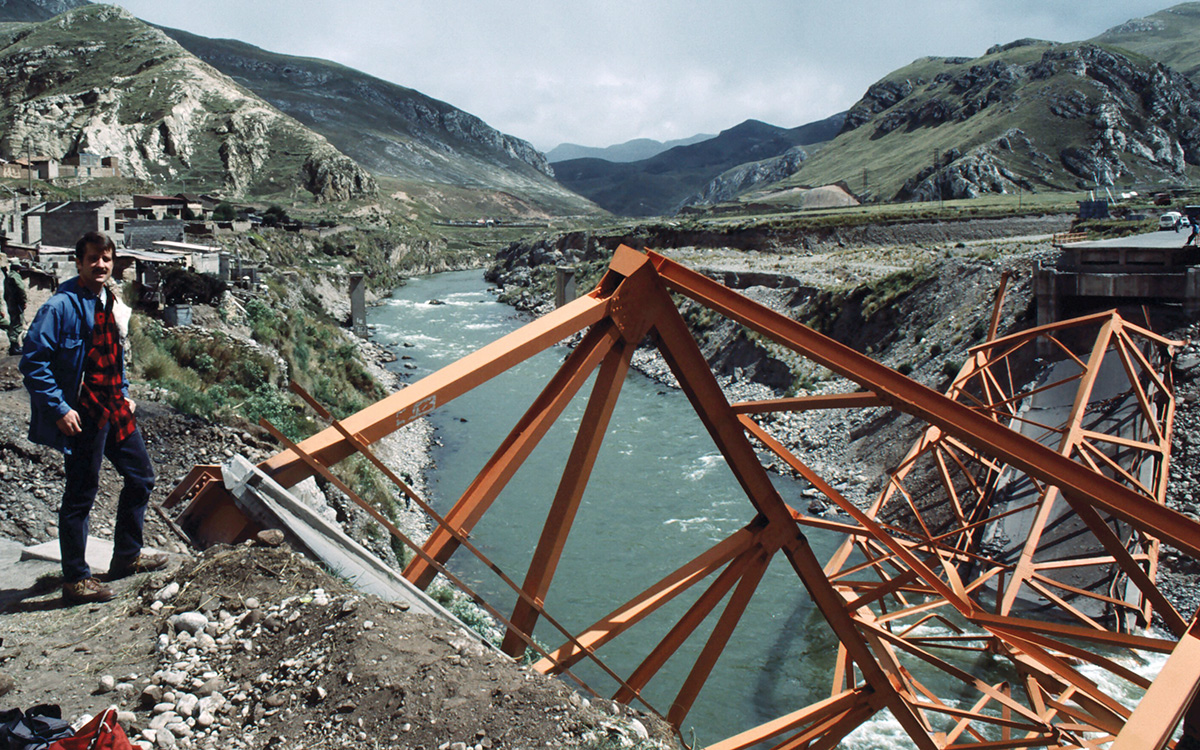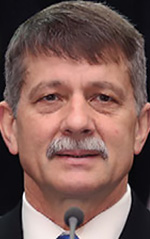Right of Boom: A Bomb and a Book
Reflections
BY STEPHEN G. MCFARLAND

In April 1987 the author visits a bridge blown up by the guerrillas in central Peru.
Courtesy of Stephen McFarland

In Colombia in 2016 as a USAID justice project head, the author rides a mule to visit communities in areas with large guerrilla and narcotics trafficker presence.
Courtesy of Stephen McFarland
In U.S. military jargon, “right of boom” is the period that immediately follows—i.e., “to the right of”—an explosion or an attack. Pithy and colorful, it conveys sensory overload and rupture: the dilation of time, narrowed vision, dialed-down hearing, and the rebooting of the brain. “Right of boom” moments, in both natural disasters and acts of violence, shape the lives of people in that subset of the Foreign Service and foreign affairs agencies who work in the gritty borderlands of foreign policy and national security.
To work in this area requires resilience. It starts with mental and emotional agility: One moment you check an area for threats; the next, you’re trying to empathize with someone on the humanitarian to war criminal continuum. One day you drive into an exchange of fire with the gods of war rolling dice; that evening, you’re home with your family. Asleep that night, your mind becomes a gonzo film director and replays the ordeal for the first time.
Camaraderie, family and a sense of purpose help you learn to navigate this uncertain terrain. Our security training is tactical and practical: the ins and outs of avoiding, mitigating or defeating threats. But even if you dodge a bullet and enjoy that fleeting rush, you must think through who else got shot and why. That’s how I came to value self-reflection and perspective as much as varying my routes or going to the range.
Ironically, a book I never read shaped my search for meaning in wartime: 501 Spanish Verbs. Seeing a copy of it in 2019 at a hostel lobby in Lima inspired me to write this piece. I was there as a Georgetown graduate student to meet with former combatants and to seek lessons from the war against Sendero Luminoso, the “Shining Path,” the fundamentalist Maoist insurgency that I had reported on from Peru as a younger Foreign Service political officer. This sighting took me back to an early lesson on working in the world of political violence and “right of boom.”
It was afternoon in Cuzco, some 11,000 feet up in the Peruvian Andes, in the summer of 1986. At the time, the Sendero Luminoso guerrillas were seeking to overthrow the state through terrorist bombings and assassinations. As the political officer who covered the growing insurgency, and the plummeting state of human rights, I traveled widely in the conflict zones—not just to report on the attacks, but also to examine why seemingly normal people would join the guerrillas to kill soldiers, police officers and fellow villagers, and why the security forces would use summary executions and torture against civilians as well as rebels.
At night we often heard the bombs and gunfire; Sendero Luminoso’s targets made clear that Americans were enemies. When we learned Sendero had just bombed the tourist train in Cuzco, killing seven persons including an American tourist, I rushed off to learn more.
As I left, the embassy gave me an additional task. Like many Foreign Service officers, I had been a consular officer during my first tour. This day in Cuzco I found myself back in the heart of consular work, assisting American citizens overseas. In this particular case, I needed to obtain the police report on the American whom Sendero had just killed.
It was sunny, but the warmest part of the day had passed, and the increasing chill and the high altitude produced a melancholy effect. I had on a coat and tie—officials in the Andes appreciate formality—but I also wore a mountaineering jacket on top, both for the cold and to better conceal my weapon. The police station was a rundown building with dilapidated furniture and mismatched file cabinets. I identified myself and met the policeman assigned to the case.
He sat in front of a manual typewriter, using his forefingers to produce the documentation of the American’s death that would allow the transfer of his body from the morgue to the capital, and then onward to his home. Poke-poke-poke, place of death. Poke-poke-poke, time of death. Poke-poke-poke, cause of death.
The explosive velocity of dynamite exceeds several thousand meters per second. Mining is common in the Andes, and so is dynamite; Sendero made improvised bombs its weapon of choice. Usually Sendero sought not just to kill, but to obliterate. For this attack, a Sendero member had packed metal objects into the bomb to produce shrapnel to kill even more people. Placed at random into the train’s overhead luggage rack, it was low-tech but cruelly effective.
The policeman finished entering the victim’s information, a black-and-white explanation that said everything about the moment of death and nothing about why. A solitary fly buzzed in the thin air.
The policeman finally asked me to look through the American’s personal effects bundled in a shredded and bloodied sleeping bag, and to decide what to keep and what to discard. I set aside the American’s passport and items of possible value, and then anything not soaked in blood.
Eventually I came to some books, and I spotted 501 Spanish Verbs. It was a staple of young American travelers in Latin America. Shrapnel had lacerated the front cover, and blood had soaked into the paper; in a cruel irony, it now spoke to what Clausewitz termed “the grammar of war.” I picked the book up and began to turn the pages.
We identify blood with life. Blood, like life, can transform itself, and it has a variety of visages and colors. This blood was dull and dark, with hints of carmine where drops not fully coagulated had broken open. Soon enough I would learn more about blood’s range of color, and the disjointed smells and sounds of its shedding. This blood had its own color; distant now from the furor, confusion and distorted sensory systems of war, it was a fellow American’s tragic death embedded in furrows traced by shrapnel.
As I turned the pages, the shrapnel indentations that stabbed the book changed. They were initially sharp and probably still deadly, but became fewer and finer: destruction’s undeciphered cuneiform. There was gradually less blood. I kept turning the pages, the signs of violence receding. Eventually I arrived at a page where there was only a faint puncture and a pinprick of blood. Then, a page with only a faint indentation—and then I turned that page, and the subsequent pages had no sign of blood nor shrapnel.
A turn of a page separated death from life. An image of hope, perhaps, but also of safety’s ephemeral nature. I held close that insight (or was it a prayer?) during subsequent years in the insurgencies in Peru, El Salvador, Iraq, Afghanistan and Colombia, as I sought to balance my duties with safety, fatalistic acceptance with free will. During periods of gunfire and mortar fire, or the quiet times when someone may be targeting you, sometimes the memory of that page suggested that all periods of violence come to an end—that even after a tragedy, when colleagues and contacts are killed, we can keep going.
When I authorized deadly force—thankfully unused—or I traveled to or sent people out to dangerous areas, it reminded me of my own responsibility, since the separation between life and death is paper thin and depends partially on a dice roll. The self-reflection that my handling of that American’s belongings engendered was, in retrospect, an essential tool to stay focused and to lead in subsequent assignments.
I put the book in the discard pile, and back at the hotel I scrubbed the blood off my hands. I took the death certificate to the embassy, and the American’s body returned home. I ramped up my reporting on the war.
After many years, I still recall vividly sorting through that American victim’s personal effects and turning the pages of that blood-soaked book. If that experience has a lesson, I believe it is that after you enter the “right of boom” world, you can’t go back—but sometimes you get to turn the page forward.




